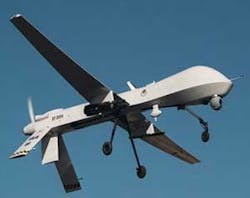Newton, MA--Bodkin Design & Engineering, LLC (BD&E) was awarded a Phase I Small Business Innovation Research program (SBIR) contract by the U.S. Air Force to develop a switchable polarizing camera element for aerial surveillance from unmanned aerial vehicles (UAVs). When retrofitted to an IR camera, the device can switch from high-resolution IR imaging mode to a polarimetric IR imaging mode.
Polarimetric imaging can improve the detection of targets under tree canopies, in camouflage, and in cluttered environments, separating man-made objects such as vehicles and buildings from clutter in a reconnaissance scene. Flat surfaces on these objects partially polarize both reflected light and thermally emitted radiation.
Current polarimetric imaging technology uses either multiple cameras with multiple filters or a single camera with time multiplexing. Multiple cameras and filters yield high-resolution polarimetric images of the scene, but lead to large and expensive systems. Time multiplexing produces high-resolution imagery but at a slower data rate and can suffer from temporal artifacts.
BD&E is designing an instrument that will map polarimetric information simultaneously onto a single focal plane, with the focal plane divided into sections for each type of information; this eliminates temporal artifacts and makes a more rugged imager, says BD&E. The design has no moving parts, is compact and adaptable to existing camera systems, and can rapidly switch between polarimetric and high-resolution imagery.
BD&E has contracts with the U.S. Army, Air Force, Navy, and Missile Defense Agency for several optical-engineering projects.

